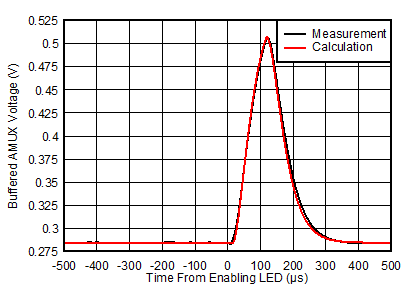SLVAEX3 October 2020 TPS8802 , TPS8804
3.1.3 Combined Signal Chain
The signal at the buffered AMUX output can be calculated using the models for each stage, as shown in Equation 7. τ1 and τ2 represent the photo input amplifier and AMUX filter time constants, respectively. Taking an integral and inverse Laplace transform of Equation 7 results in the time-dependent step response in Equation 8. Here, H(t) is the Heaviside step function, taking the value 0 for negative inputs and 1 for non-negative inputs. The step response assumes that the photocurrent is stepped from 0 to IPD when t is equal to 0. The step response calculation in Equation 8 is undefined when τ1 and τ2 are equal. In this case, the limit can be taken to solve for the step response.
With the step response calculated, the response to a rectangular pulse input is calculated in Equation 9, where tLED is the LED pulse width. Equation 10 and Equation 11 calculate the baseline DC voltage of the buffered photo signal with and without a 470 kΩ resistor installed on PREF. VPDO(OFS) is the DC offset caused by the photo input amplifier and VPGAIN(OFS) is the DC offset caused by the photo gain amplifier. Because there is a propagation delay on the TPS880x LED driver, the output may be shifted from when the LED is enabled.

| τ1=33 µs | τ2=30 µs |